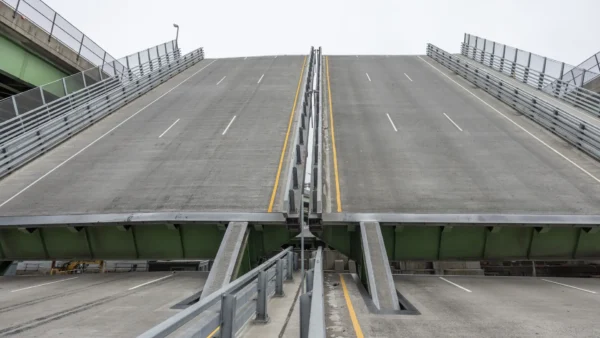In an unprecedented move, the British-headquartered financial services giant Legal & General (L&G) will build the largest home-building factory in Europe in a bid to shake up the UK’s failing housing market.
The insurer and institutional investor will spend $77m (£55m) setting up a factory near Leeds in West Yorkshire capable of pumping out 3,000 houses or 4,500 flats a year with cutting-edge manufacturing techniques that involve no traditional construction tradespeople.
But that is just the beginning: it plans to invest a further $700m (£500m) in building more home-factories across the UK in what would be the biggest push for offsite manufacturing of homes since the end of the Second World War.
What we’re looking to do is have a design suite where tenants and residents can come and almost design their own homes– Robert Hall, L&G Homes
If successful, the plan could rewrite the rules of the UK housing market, which has seen prices soar amid an undersupply of homes stretching back decades.
L&G has set up a new division known as L&G Homes to launch the offsite manufacturing campaign, and it has a war chest of $11bn (£7.9bn) to invest in housing and infrastructure, UK magazine Inside Housing reported yesterday.
Robert Hall, head of business development at L&G Homes, said: “L&G made a board decision to invest £55m into the largest offsite manufacturing facility in Europe, in Leeds, with an in principle commitment to invest a further £500m into replicating that facility across the UK.
“What we’re doing is true offsite manufacturing. The process we use involves no tradesmen, zero. The homes will be built complete in the factory, carpets, curtains, white goods, television.
“All the units are not a set pattern, you can have any design you wish. What we’re looking to do is have a design suite where tenants and residents can come and almost design their own homes.”
Tom Ground, former head of ventures at L&G Capital, will be L&G Homes first chief executive.
The factory will be formally launched in the coming weeks and will be able to deliver complete homes with full internal features and modifiable designs, Inside Housing reported. They will be built to a high standard of energy efficiency, and are expected to cost just $118 (£85) a year to heat.
In January, L&G announced a tie-up with Dutch pension fund PGGM to build 3,000 private rented sector (PRS) homes. It already has three Build to Rent development schemes in its portfolio; Bristol, Salford and Walthamstow, forecast to deliver over 650 homes.
Peter Quinn, business development director at another UK housebuilder, Lovell, told Inside Housing that the new factory would be “an absolute game changer” for the industry.
Probing for solutions
For some time the UK government has been probing the possibilities of offsite manufacturing as one solution to the country’s seemingly intractable housing crisis.
What we’re doing is true offsite manufacturing. The process we use involves no tradesmen, zero. The homes will be built complete in the factory, carpets, curtains, white goods, television– Robert Hall, L&G Homes
The theoretical benefits of offsite manufacturing are well rehearsed: prefabrication ought to allow the construction industry to erect warmer buildings at greater speed and for less money than traditional methods.
Market barriers have prevented the technique’s take-up, however. A government-commissioned report published in 2013 found that volume house-builders, who together account for about two-thirds of all home sales, prefer traditional construction methods because they fit better with established business models.
But the review said the status quo could change as other market segments, such as the private build-to-rent sector, social housing providers and local authorities, explore the benefits of offsite techniques.
Other initiatives are underway as well. A year ago the UK government gave $31m (£22.1m) to a consortium of top universities and companies – led by contractor Laing O’Rourke – to study the advanced manufacturing of homes and other structures over four years.
Photograph: The UK housing market has seen prices soar amid an undersupply of homes stretching back decades (Simon Dawson/Bloomberg/Getty Images)
Comments
Comments are closed.







Fantastic news, definitely a step in the right direction. Prefabs worked well in the last war and for 50 years afterwards. As Paul says, variants are the cost killer: but how many variants do the current mass producers offer? In the USA new house prices are 50% less than the UK and homes are 25% larger. OK, land is cheaper there but controlled prefabrication is the main reason.
One major house builder is paying a dividend this year equal to £23,000 per house built; it’s definitely time there was some proper competition to make houses far more affordable.
Finally some one has woken up to the fact that if you are the landowner, developer and manufacturer anything is possible. I’m certain Mr Richard Ogden at Build offsite will be over the moon with this statement of intent and if anyone needs a pat on the back for pushing all these years, its Richard.
I am certain that L and G will be aware, but needless to say factories only work well when used correctly and not when everyone wants a variant from what can be mass produced or standardised
In principle this sounds great – particularly the low running costs of the home- but the question I have is if the cost of construction is lower (due to speed) will this genuinely lead to more affordable homes? Properties are put on the market at the market rent/value and all a reduced cost of construction will lead to is a greater profit for the supplier. If the manufacturer puts the property on the market at cost of construction (including fees/land etc.) plus whatever profit the choose to earn what will prevent the first buyer selling it on at market price making a significant profit and failing to address the “affordability” issue in the long term? How flexible will the design be if a future owner wants a different layout?
i’m surprised this has not been done sooner, i know the main two issues are set-up costs and obtaining land on which to build, what has made housing expensive is suitable planning permissions (and time taken) and lack of skilled trades persons, therefore deskilling the building trade will reduce labour costs and also reducing the amount of waste that is produced this should help to reduce the cost of each unit. it will be interesting to see what the take will be, the building industry is always slow to take up new ideas unless there is a major financial benefit.
I will watch this space with great interest. The issue in the UK is land, climate. Overseas, particularly in the Middle East, the land is not so much of an issue, whereas labor is. It is a mix on varying skills or imported at great cost. The key is factories. Minimize the labor on site and pre manufacture as much as practicable in the factory.